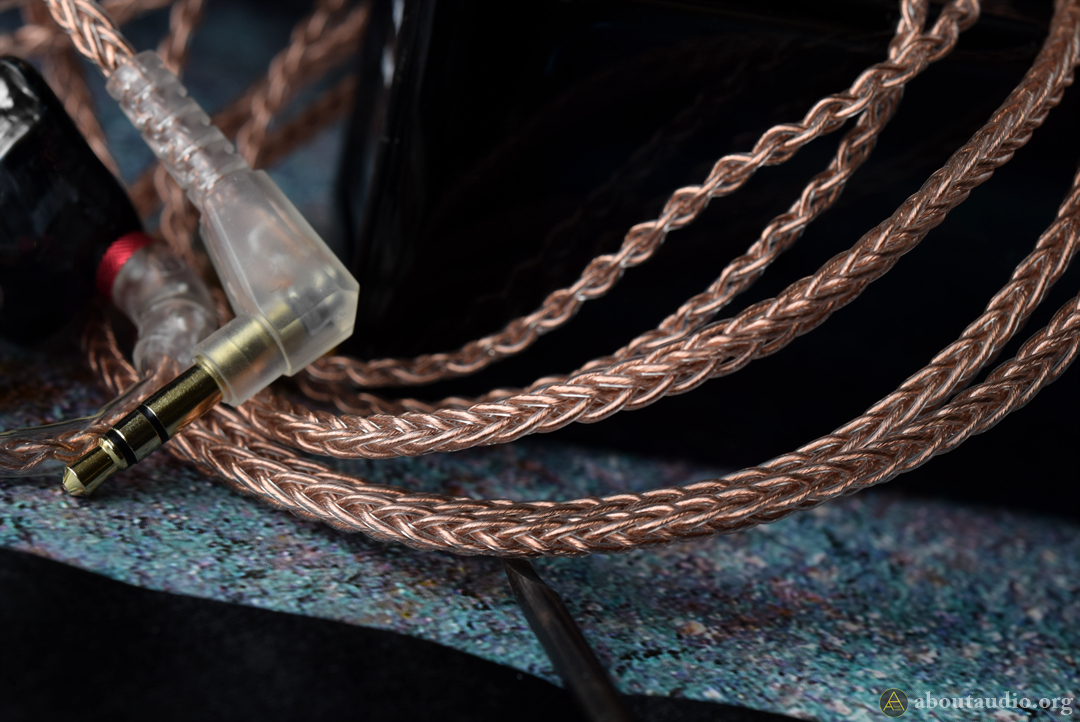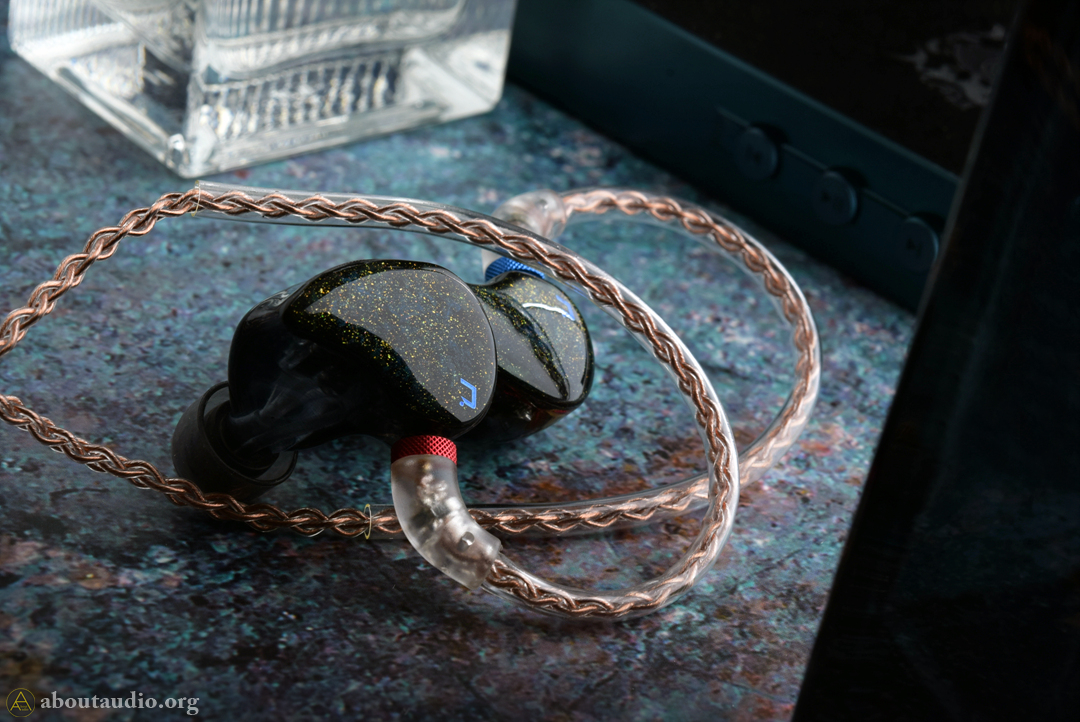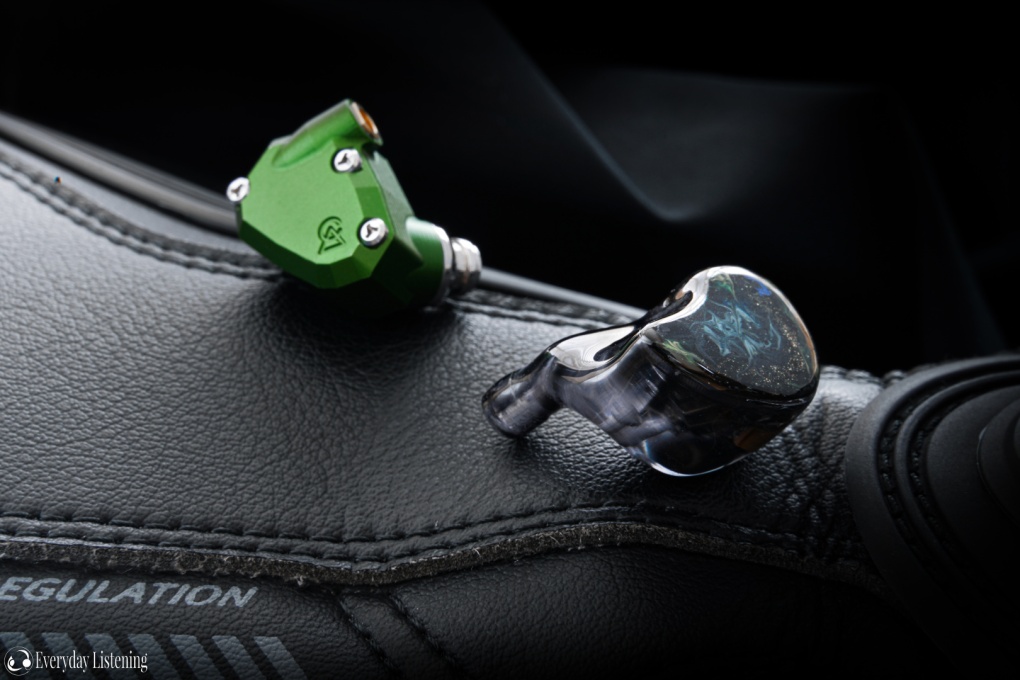TLDR -
The Opera’s magic lies in its ability to bring every element together into a highly coherent, composed and effortless whole.
Introduction –
If you’re reading this article, chances are you’re familiar with Knowles, NuForce or Erato. If that’s the case, then you would be well acquainted with Casey Ng whose expertise was invaluable to all. NXEars is his latest venture, uniting the core principles of each brand. These earphones feature strong value per driver from his relationship to Knowles, a phase-coherent crossover ala NuForce and have been tuned to perform well in both time and frequency domains. The Opera is NXEars’ statement product, with a 3-way, 8-driver configuration and a $799 USD asking price. You can read more about the line-up and technology behind NXEars
here. With that in mind, these are my impressions.
Disclaimer –
I would like to thank Casey very much for his quick communication, clarification and for providing me with the Opera for the purpose of review. All words are my own and there is no monetary incentive for a positive review. The earphones have been reviewed under flexible terms meaning that they will be shipped back as required by NXEars. As always, I will attempt to be as objective as possible in my evaluation. This review also features a pre-production unit that came with no packaging nor the full set of accessories. The retail units will also feature heavy copper faceplates that Casey assures will enhance bass heft.
The Pitch –
Aperiodic Ground Loading
Casey’s patent-pending AGL technology isn’t fleshed out on NXEars’ website but is a development that is worth taking some time to understand as it contributes to some key characteristics of the Opera’s sound. It consists of driver body damping on the faceplate in conjunction with a vent that controls driver resonance while bleeding over-pressure. As a result, these will be very non-fatiguing on the eardrum and low in distortion.
Multi-way Crossover
The Opera implements a sophisticated crossover system to achieve a low-distortion and linear sound. It is both frequency and time-aligned ensuring phase coherence in addition to a smooth and coherent frequency response. In real-world listening, this should translate to clean transients and sharp imaging. There are only a handful of phase-coherent earphones on the market, notable to me are the JH and Custom Art flagships that are all more expensive than the Opera.
Design –
I personally love the design of the Opera which merges elements of custom and universal IEMs to create a very unique aesthetic alongside excellent ergonomics. The 3D printed housings are perfectly realised with an immaculate gloss finish and a complete absence of bubbles, seams or defects. The smoke design provides a window into the complex driver and crossover designs inside. Meanwhile, stardust blue faceplates glittered with lustrous gold accents provide a truly otherworldly aesthetic that is gorgeous to photograph and even more captivating in person.
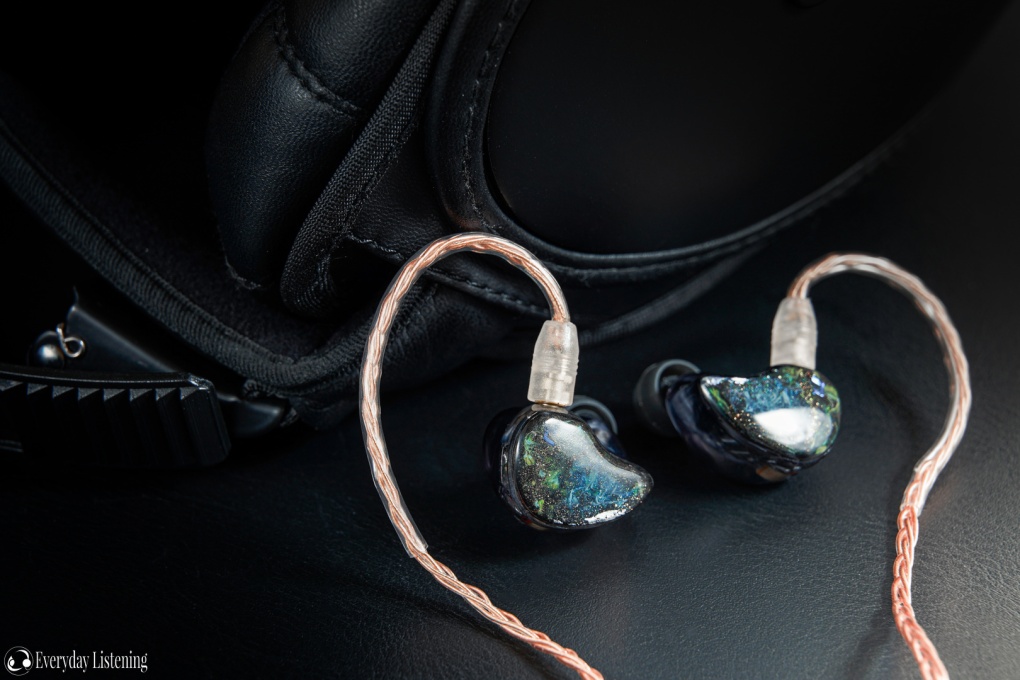
This is complemented by a removable MMCX cable with 8-core 6N mono-crystal copper conductors. It’s very soft and easily coiled for storage. The jacket is a touch rubbery which can make untangling difficult; however, the 8-wire braid does resist tangling very well. There is ample strain relief and convincing build quality without cumbersome weight. The memory wire ear guides hold their position well and provide a confident fit. Meanwhile, the MMCX connectors themselves are snappy and even in tension between sides.
Fit & Isolation –
The housings are on the larger side both in terms of height and depth, however, they are very smoothly formed and sculpted to complement the features of the outer ear. In conjunction with long, tapered nozzles that provide a deep fit, the Opera feels very stable and locked into the ear. I also found the deeper fit to permit the earphones to sit flush with my outer ear while their sculpted design avoided hotspot formation over longer listening.
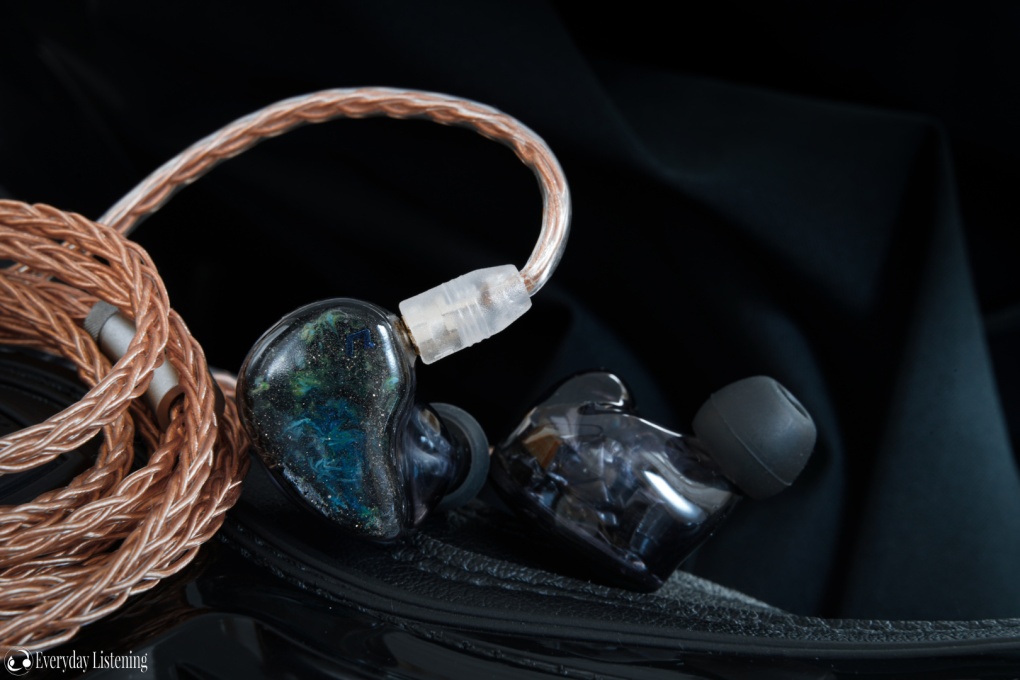
Due to their vented nature, isolation is good but not outstanding like a custom or fully sealed design. They are still perfectly suitable for commute and potentially air travel with foam tips that said. On the contrary, though functionally different, I did find AGL to provide similar pressure relief to my ADEL and APEX earphones which makes them very comfortable for extended listening despite their fit depth. They provide a similarly strong seal to other high-end IEMs but without the vacuum so the Opera will be a good choice for those sensitive to that kind of discomfort.
Sound –
Testing Methodology: Arta via IEC 711 coupler to Startech external sound card. Note that 7-9KHz peaks are artefacts of my measurement setup. Casey confirmed to me that the earphones do have a small ~10KHz emphasis but not nearly to the degree indicated here. Take this graph with a grain of salt. Measurements besides channel balance are volume matched at 1K.
Tonality –
The Opera is a mid-centric earphone with a powerful full-bodied, dense voicing and excellent layering. Sub-bass takes a backseat to a very linear mid-bass while a moderate emphasis in the upper-bass imbues a pleasing warmth and euphony into its presentation. There’s a small dip in the lower-midrange that heightens tonal transparency before a rise into the centre midrange for vocal presence and clarity. A dense upper-midrange and smooth lower-treble yield a velvety smooth articulation, while an uptick of 5KHz emphasis retains pleasing crispness and clarity. The background is dark and clean rounding off a highly resolved and coherent if not highly dynamic and separated presentation, I certainly do not hear anything like the peak showcased on my measurement but a nice presence that grants some additional air and headroom. This is another unique earphone that doesn’t trace any conventional curve but does yield a highly pleasing listen with some impressive technical qualities on top.
Bass –
I deliberated over these comments for quite a while, due to AGL there’s
zero sense of pressure from the sub-bass. As such, I would be inclined to suggest that extension isn’t the best, however, any audible if not visceral sub-bass information is present in the track. There remains a very tight slam and defined rumble occupying a laid-back position but due to the lack of pressure, you never feel the sensation of moving air which can make sub-bass feel insubstantial. Meanwhile, mid-bass is flat, linear and clean while a moderate bump in the upper-bass imbues warmth and satisfying note fullness that prevents the presentation from straying into sterility. This creates a low-end that is clean yet musical and never stark if a touch tubby on tracks already mastered with additional warmth.
Casey mentioned that PRAT was a prime focus with this earphone and though I find the earphone’s transient response is best showcase by its treble, bass carries some very convincing properties too. Lows are agile and tactful, driver control is very high and notes are presented in standard BA fashion, being very quick in both attack and decay. It’s a punchy if not hard-hitting presentation that showcases outstanding definition and strong organisation, even when reproducing complex and bass abundant tracks. This comes at the cost of dynamics as the Opera dissects tracks but with subjectively limited range. Still, that is not to say this is not a satisfying listen, not in the slightest; bolstered body and warmth contribute to a grand stage propagated by full, well-resolved notes.
Mids –
Over extended listening, it’s the midrange that’s really grown on me; the presentation is sublime. The Opera places vocals at the forefront of its presentation yet sans any form of intensity or forwardness. These are also vocals worth showcasing; high-resolution and naturally toned and voiced. With moderate warmth in the low-end, a small lower-midrange dip prevents spill and veil while retaining body and smooth integration for precise instrument and vocal reconstruction. Meanwhile, rising emphasis to a natural hump around 3KHz before subsequent 4KHz dip yields a natural voicing with good clarity.

This is a delightfully musical presentation that finds harmony between musicality and transparency. Sure, the presentation carries a light warmth and full notes but it is wholly resolved without a hint of thinness, rasp or over-articulation. Similarly, though reasonably clear and intimate, never is the vocal presentation chesty or veiled nor strident and overly-forward. The presentation is rather, naturally toned, not perfectly accurate in timbre but rich and portrayed with perfect density and great smoothness so as to maintain ample extension.
The earphones possess convincing vocal clarity and very impressive resolution with excellent layering and notes that are highly defined despite their smooth articulation and full body. The Opera is, therefore, perfect for the vocal lover and boasts a very sound instrument timbre that enables them to excel with acoustic, classical and jazz while upholding enough clarity and energy to flatter other genres too. Unlike many high-end models out there, the midrange steals the show to my ears and this is an excellent thing as the bulk of musical information is contained in this frequency range.
Highs –
The top-end is crisp and well-detailed with very clean transients. It is defined by a modest 5KHz peak followed by a 6KHz trough and lack of any subsequent background brightness. Despite being small in magnitude, this is a narrower emphasis that produces a thinner instrument body. Nonetheless, texture and decay are both natural and notes are well resolved overall. By attenuating the 6KHz region, sibilance and sharpness are mitigated and this tuning retains a crisp image with just a hair of warmth. The net result is a slightly smoother note attack which results in a note presentation that is thin and highly defined but never fatiguing or uncontrolled. Detail retrieval is good both in the foreground and background but some competitors offer slightly more insight here.
Meanwhile, the especially clean transient response aids this IEM’s outstanding note definition and spatial positioning. Upper-octave extension is also what you would want from a high-end IEM, but there is little sparkle and diminished air due to the darkness of its tuning within the middle and upper-treble. Still, the Opera provides an immaculately clean space that greatly contributes to its defined and layered presentation in addition to retrieving enough background detail to enable an involving sense of distance and scale. Again, there isn’t abundant shimmer, pristine clarity or energy up top, but a controlled and focussed detail presentation with great contrast between foreground and background.
Soundstage –
The presentation is something special. After trying a few of Casey’s earphones such as those from NuForce and the NX Ears Basso, the Opera exemplifies everything he’s strived to achieve. Some will be surprised that the soundstage isn’t the largest, expanding just beyond the head in width with more intimate depth but certainly not providing boundless presentation of say, the Campfire Audio Andromeda. Instead, the focus of the Opera is its imaging. Vocals occupy a very strong centre image while layers are highly defined and the background well resolved. Defined, clean transients produce pinpoint precise directional cues and panning. These qualities give its presentation great dimension and a holographic sense of positioning. Separation is also quite good. Though the earphone is warm with large notes, tending to prioritise coherence, the highly organised nature of its presentation makes it easy to pinpoint small details.
Driveability –
The Opera is efficient with a 106dB sensitivity and 18-ohm impedance. It has been designed to keep impedance within a range friendly for most devices. In turn, I found the Opera impressively resistant to hiss but still susceptible to output impedance if to a lesser degree than some competitors. Comparing between the 10-ohm Hiby R6 and Shanling M2X, for example, I heard a markedly smoother and darker sound from the Hiby. Bass transients became softer while mids became fuller and smoother. Highs were attenuated losing some shimmer and crispness. As such, a low output impedance source is desirable to extract maximum fidelity from the Opera but those wanting a warmer sound can experiment with impedance adapters. The earphones’ resolving nature also lends them well towards dedicated sources where they sound noticeably cleaner with more involving imaging.
Comparisons –
Audiofly AF1120MK2 ($699): The AF1120MK2 is also a nicely balanced and natural sounding earphone. It provides more slam at the very bottom and a more mid-bass focussed low-end, being warmer and fuller with more natural decay on top. Altogether, this makes it more dynamic with greater range. The Opera, meanwhile, is more controlled and agile, with noticeably more note definition and organisation on complex tracks. The midrange shares similar values but different approaches. Both are also smooth, natural and place vocals forward. Where they most differ is with regards to vocal size, being bigger and more powerful on the Opera, and density, the Opera also offering meatier notes. The AF1120MK2 isn’t as full-bodied, instead providing a touch more warmth counterbalanced by greater clarity and upper-midrange extension.
The Opera has noticeably higher resolution through the midrange. Both earphones feature a lower-treble dip and peak tuning, 5KHz emphasis on the Opera, 6KHz on the Af1120MK2. Neither are sharp or bright, nor sibilant. The Opera is a touch more detail-forward, it has slightly more defined transients while the AF1120MK2 has a touch more warmth and instrument body. The Opera is more detailed, it has a more immaculate background and better extension. The Opera’s soundstage trumps the Audiofly, being larger and also more organised, with a stronger centre image and slightly more defined layers.
Campfire Audio Andromeda ($1099): A staple around this price range, providing a more u-shaped and vivid tuning. Sub-bass extension is better on the Andromeda with more slam and rumble. It has noticeably more mid-bass presence and a touch of emphasis in the upper-bass too. As such, it’s low-end is noticeably larger, warmer and fuller but also more dynamic. The Opera has less depth and power but greater cleanliness, higher control and more defined notes, being punchier and more tactful. The Opera has noticeably more forward vocals and a more natural timbre, the Andromeda rather has greater clarity with more upper-midrange presence and it’s a touch warmer too from its bass. The Opera has more body and is much denser with smoother articulation, it is more coherent with greater note definition and resolution.
On the contrary, the Andromeda is more delicate but also over-articulated and raspy making it sound very glossy if less accurate. However, it also has greater ability to project distance and depth. The high-end is brighter throughout on the Andromeda. It is more aggressively detailed with more pristine clarity and air. The Andromeda has more detail retrieval but it is also splashier which will depend on listener preference. The Andro has better extension and a lot more sparkle, while the Opera is darker and more layered. The Andro has a much larger soundstage, especially depth due to its more laid-back vocals and though it also has a clean transient response, the Opera has more defined directional cues and layers, being more intimate but also more holographic and organised.
Meze Rai Penta ($1099): The Rai Penta sports a similar style of sound too but is more W-shaped with greater tri-frequency separation. It has much more bass extension and lows are more mid-bass focused. The Penta has a fuller low-end with more natural decay and greater dynamics and drive. The Opera is more controlled and much quicker decaying, so it is more defined and organised but also lacking the same depth and information in the sub-bass. Both have similar midrange tuning, being smooth and well-bodied. The Opera has larger vocal size while the Penta has more forward vocals but without the same body and power as it lacks the same kind of upper-bass bolstering. Still, it carries a light warmth but is clearly not as dense and full-bodied as the Opera.
The Opera has higher midrange resolution while the Rai Penta has better extension, depth and clarity. Up top, the Opera is slightly crisper and more aggressive while the Rai Penta is smoother and more organic. The Rai Penta has slightly more foreground detail retrieval, while the Opera has slightly more background detail retrieval. Both extend similarly and feature clean, dark backgrounds, the Opera to a slightly greater extent while the Rai Penta has a touch more air. The Rai Penta has a larger soundstage, especially width. Depth is more intimate on both, the Penta also projects a bit better here too. Both also layer very well, but there is more definition on the Opera and sharper directional cues and directionality.
Custom Art Fibae 7 (~$1225): The Fibae 7 is a formidable earphone, highly rated even at its higher price and praised for its timbre and balance. It immediately has much better sub-bass extension with more solid slam and rumble. The Fibae 7 has similar mid-bass presence and a cleaner upper-bass, producing a cleaner and more linear low-end than the Opera. The Opera meanwhile is quicker decaying and more defined through the mid-bass with a bit more separation while the Fibae 7 is invariably the more dynamic earphone. Through the midrange, the Fibae 7 treads a very impressively reference line, the tone, body and smoothness all operate at relatively neutral levels compared to the dense and powerful Opera. The Opera is more full-bodied and smoother while the Fibae 7 is a touch more forward in positioning with more neutral vocal size.
The Fibae 7 has slightly higher resolution and definition in addition to boasting more extension while the Opera has meatier notes with more defined layers. The top-end is more detailed and extended on the Fibae 7. Its foreground is more linear with more accurate instrument body, texture and greater detail retrieval. The background is immaculately clean on both, darker on the Opera but with more resolution and micro-detail on the Fibae 7. Neither have much sparkle, the Fibae 7 has a larger soundstage, it doesn’t have quite the same layering and holographic imaging as the Opera, however, it has better separation and similarly strong organisation.
Verdict –

The hallmark of a great high-end IEM is a certain je ne sais quoi; some fine quality that can’t necessarily be reasoned but one that captivates, nonetheless. The Opera provides such character, a vector with direction and magnitude. The midrange enthrals the listener, with powerful, meaty notes accompanying larger than life vocal size and impeccable definition and resolution. Meanwhile, highs showcase a clean transient response that contributes to a highly organised presentation with truly outstanding imaging. The low-end is perhaps the weakest link. Though it certainly carries itself with excellent pace and organisation, bass sounds flat and lacking in dynamics in addition to being somewhat strange and unconventional in terms of tonality. This is unfortunate as many listeners tend to start their analysis from bottom to top, leaving a poor first impression. However, give the Opera some time – this is not one to awe in the way that it construes any particular frequency range. Rather, the magic lies in its ability to bring many elements together into a highly coherent, composed and effortless whole.
The Opera is available from on NXEars for $799 USD. I am not affiliated with NXEars and receive no earnings from purchases through this link.
Thanks for reading! If you enjoyed my review, please see my website for more just like it!
Track List –
Billy Joel – The Stranger
Blur – The Magic Whip
Courtney Barnett – MTV Unplugged
Dire Straits – Communique
Fleetwood Mac – Greatest Hits
Joji – Sanctuary
keshi – skeletons
Lauv – I met you when I was 18
Nirvana – Nevermind
Radiohead – The Bends
Rich Brian – The Sailor
Tears for Fears – Songs From The Big Chair
The Velvet Underground – Loaded







